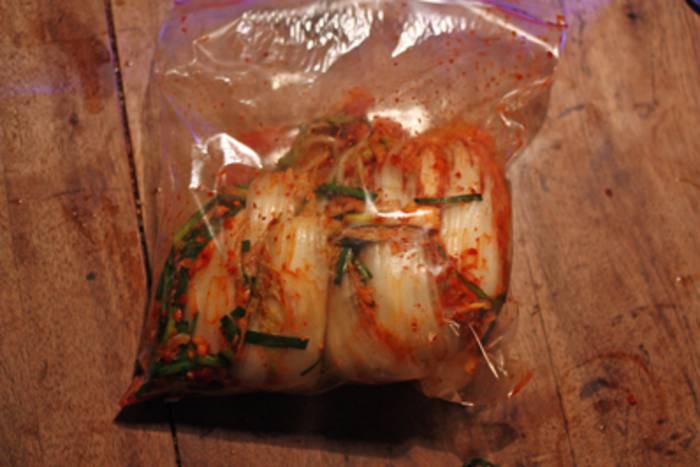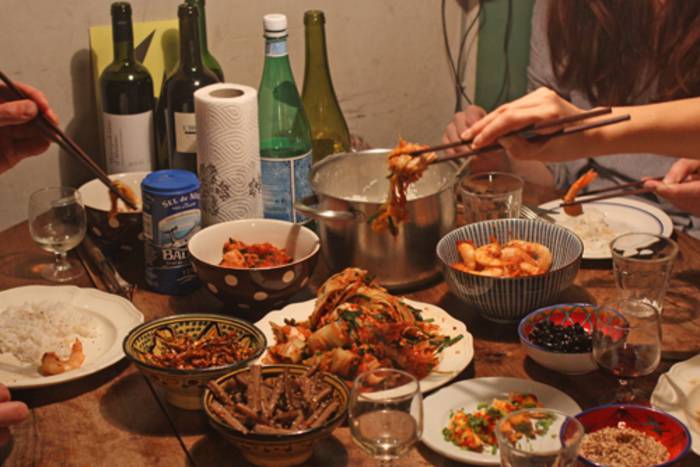the Ficticious Island Santa Lemusa
Neuste Beiträge
- Eine Premiere in Weimar: die Kisten der Kukaldaria
- Bericht aus Raum Nummer 8: Miso
- Diese gehackte Hühnerleber ist einer Hexe gewidmet
- Marrokos goldene Königin - die Salzzitrone
- Revidierter Klassiker aus Syrien: Tabouleh
- Ein Dip vom Kap Domèn: Kawotaise – aus Karotten und Süsskartoffeln
- Fuss vom Schwein, im eigenen Gelee gefangen: Pieds de porc St-Antoine
- Um ein Haar wärs ein Palast geworden: Panais royal
- Aus Sehnah: Brotsuppe mit Hühnerherzen
- Salzig uminterpretiert: Bananenschaum mit Seehasenrogen
- Ergiebig uns schön: Terrine aus dem Kopf eines Spanferkels
- Ein überraschender Apéro-Snack: Oliven auf senegalesische Art
- Was wäre Asien ohne die Rote Bohnenpaste
- Senegals Nationalgericht Thiéboudienne
HOIO und Cookuk
- Das Tagebuch von Raum Nummer 8 (Susanne Vögeli und Jules Rifke)
- HOIO-Rezepte in der Kochschule – das andere Tagebuch
- Immer ein Experiment wert: Vakuum-Fermentation (Grundrezept)
- Überholter Klassiker – Boeuf à la mode d'aujourd'hui
- Viel Geschichte, viel Gelatine – Bœuf à la mode (Rinderschulter mit Karotten)
- Klassiker aus Korea – mit modernen Mitteln hergestellt: Kimchi – im Vakuum fermentiert
- Die Salzgurke – ein Klassiker aus dem Königreich der Milchsäuregärung
- Wundersame Transformation im Beutel: milchsauer vergorene Spargeln
Etwas ältere Beiträge
- Pfeffrige Suppe aus Singapur: Bak kut teh
- Rauchzeichen von Trobriand-Inseln: «Mona» – ein Taro-Dessert
- Leichte Kost mit Gewicht: Taschenkrebs im Sud gekocht
- Aus Singapur: Hokkien hae mee, Nudeln mit Garnelen
- Alles mit «P»: Peter Polters Peterli-Pastinaken
- Wärmendes aus Tocantins: Caldo de Chambari
- Osmanische Kuttelfreuden, im Handumdrehen zubereitet: İşkembe Çorbası
- Zwischen Nase und Schwanz: Kaninchen-Innereien auf Knollensellerie
- Ein sensorisches Erlebnis schönster Art: Xiǎolóngbāo – Teigtaschen aus Shanghai
- Ein vegetabiles Gehirn aus Lyon: Cervelle de Canut – Frischkäse mit Kräutern und Gewürzen
- Im Namen von Laozi: Zwetschgeneis mit Ingwer
- Schnelle Erfrischung für warme Sommerabende: Melonenkaltschale mit Buttermilch und Minze
- Selbst gemacht ein würziges Küchenkunststück: Dresdner Sauerbraten
- Der kasachische Klassiker Beşbarmak wird am besten mit den Fingern zum Mund geführt
- Gilt als das Nationalgericht von Kasachstan: Kuurdak – ein Eintopf aus verschiedenen Innereien vom Rind
- Kaum ein anderes Gericht ist im Osten von Kasachstan so populär wie Laghman (Лагман), ein Gemüseragout mit Nudeln und wenig Fleisch
- Aus der Nachbarschaft von Milano Centrale stammt diese Lattichsuppe mit Taleggio
- Aus La Puiguignau stammt die blumige Gewürzmischung «Sourire», bei der Entsteheung auch Paul Gaugin seine Finger mit im Spiel hatte
- Eine sehr leichte, feine und würzige Suppe mit ein bisschen Fisch: S'ngao chrouk trey – ein Rezept aus der Khmer-Küche
- Passt zu Fleisch oder Klebreis – Jeow Som, ein säuerlich-scharfer Dip aus dem nördlichen Laos
- Fürchterlich altmodisch und einlullend aromatisch: Choux de Bruxelles à la crème nach Ali Bab
- Ein kulinarisches Monument aus den sechziger und siebziger Jahren: Chicken Kiev
- Nicht aus Russland, sondern aus der Ukraine: Borschtsch wärmt auch als vegetarische Suppe
- Ein west-östlicher Wickel aus Mallorca: Llom amb col – Schweinelende in Wirsing
- Ein Klassiker aus der Lombardei: Trippa alla milanese – eine Kuttelsuppe mit Saubohnen
Grosse Projekte
- 2002 - Einweihung der mobilen Boutik von HOIO in Genf
- 2003 - «Autorretratos» – Inszenierungen in Santa Lemusa und Buenos Aires
- 2004 - «Waiting Room» im Kunsthaus Baselland
- 2005 - Das Geheimnis einer Spalte auf der Älggi Alp
- 2006 - «It's only Beluga» - ein kulinarisches Alphabet
- 2007 - Einweihung des Handwagens von HOIO in Ivry su Seine
- 2008 - Geheimagent Hektor Maille bricht zu seiner mehrjährigen «Mission Kaki» auf
- 2010 - HOIO stellt seine globale Gewürzmischung «World No 1» vor, zunächst in Kinshasa
- 2011 - Salon de Lecture in der Kunsthalle Mulhouse
- 2012 - Im Rahmen des Projekts «44/33» taucht Santa Lemusa im Stadtspital Triemli auf
- 2012 - In Riehen bricht ein Papierboot auf zu seiner Reise nach Santa Lemusa
Mundstücke
- Ahornsirup
- Anis
- Apfel
- Aprikose
- Artischocke
- Aubergine
- Banane
- Bauch vom Schwein
- Blumenkohl
- Brust vom Huhn
- Chili
- Fenchel
- Fuss vom Schwein
- Gewürznelke
- Gurke
- Herz vom Rind
- Kapern
- Karotte
- Kombu
- Kopf vom Schwein
- Koriander
- Kubebenpfeffer
- Kutteln vom Rind
- Kürbis
- Leber vom Lamm
- Limette
- Lorbeer
- Lunge vom Lamm
- Magen vom Huhn
- Majoran
- Mangold
- Maniok
- Melone
- Muskat
- Nigella
- Olivenöl
- Pastinake
- Perilla
- Petersilie
- Pfeffer
- Rhabarber
- Rosenkohl
- Rotkohl
- Rotwein
- Salz
- Schwarzer Kardamom
- Schwarzwurzel
- Seeigel
- Sichuanpfeffer
- Spargel
- Stangensellerie
- Taschenkrebs
- Tiger-Fugu
- Tomate
- Zimt
- Zitrone
- Zucchini
- Zunge vom Rind
- Zwetschge
Gewürze aus Santa Lemusa
- Anis «Désir de Tikk»
- Chili «Krot Kriket»
- Chili «Papok»
- Chili «Piment Cancan»
- Fenchel «Fnui de Castebar»
- Gewürznelke «Bourdons d'Ejac»
- Kardamom «Kap de la Bandole»
- Koriandersamen «Kantalil»
- Kreuzkummel «Chera de Sentores»
- Kubebenpfeffer «Cubèbe de Sugiau»
- Kurkuma «Meriti Kochon»
- Lorbeer «Loia d'Askatas»
- Mohn «Grains de Liliac»
- Muskatblüte «Macis Coco»
- Muskatnuss «Miskat Coco»
- Nigella «Mystèr de Maizyé»
- Pfeffer schwarz «Senpuav nwè»
- Pfeffer weiss «Senpuav blan»
- Piment «Mussagor»
- Safran «Crocus Mont Fouet»
- Salz «Neige Bandon»
- Salz geräuchert «Neige Fim»
- Salz grau «Le Noir Stendhal»
- Salz rosa «Le Rouge Stendhal»
- Schw. Kardamom «Queue d'Éléphant»
- Senf schwarzer «Moutad de Maioli»
- Sesam «Sésame Baba»
- Sichuanpf. «Rougeurs de St-Brice»
- Sternanis «Baschi Dao»
- Thymian «Thym de Carbelotte»
- Wacholder «Perles de St-Anne»
- Zimt «Kannèl d'Oscar»
- Zimtkassie «Bois des Brumes»
Abkürzungen
- Grosses Popup-Fenster Karte von Santa Lemusa
- Grosses Popup-Fenster Karte der Hauptstadt Port-Louis
- Sämtliche Gewürze von HOIO: Boutik «Masalee» (Seite im Aufbau)
- Grosses Popup-Fenster Weltkarte Episoda (Mittelpunkt Zürich)
At a market on Jungangno Street in Gwangju a woman rubs cabbage leaves with kimchi marinade.
Tong Baechu Kimchi
Whole Cabbage Kimchi
Koreans seem to strive to burn schnapps out of everything – even stones. That holds good also for kimchi – there's hardy any vegetable in Korea that is not «kimchi-ised» through fermentation. No wonder there are more kimchi recipes than Koreans on this planet.
One can find innumerable instructions and guides on the Internet and in cookbooks on how to prepare the widely known Tong Baechu Kimchi, kimchi made of whole Chinese cabbage – with every manual recommending a different method of preparation. The basic ingredients for Tong Baechu Kimchi are Chinese cabbage (Korean Baechu), spring onions and, quite often, radish (usually Daikon radish) – but carrots, mustard leaves, leeks, watercress, parsley, algae, etc also go into its preparation
The cabbage and other ingredients are at first marinated in brine, which can be of vastly different potencies, ranging from mild to very strong, after which they are spiced and fermented over a period of several days – a process that gives them their typical kimchi flavour and also ensures their long-term preservation. The basic spices are ginger, chilli (mostly in the form of the coarse Korean chilli powder, Gochugaru) and garlic. It also includes the addition of some form of fish and seafood: in the simplest case, fish sauce from the bottle (made of sardines or prawns); in more refined cases, salted prawns or sardines (Korean Jeotgal), fresh or preserved oysters (Korean Gul), salted yellow corvina (a popular Korean fish from the Sciaenidae family, the drummer, or umber fish).
Kimchi is served with almost every meal as a side dish (Banchan) and is usually eaten with white rice. On his journeys through Korea, Hektor Maille naturally got his money's worth of kimchi – and also took keen interest in learning how it is prepared.
The preparation of kimchi depends on a certain time management: salting of the cabbage takes about six hours, the initial fermentation at room temperature lasts for roughly 12 hours and the subsequent fermentation for about three days. Those who do not have so much time can opt for the quick alternative of making simple Baechu Geotjeori (fresh Chinese cabbage kimchi).
Ingredients (for 10 persons)
1 or 2 big Chinese cabbages of in total 1½ or 2 kg
salt (at least one cup)
1 not too big, white radish (Daikon radish) of 300 to 400 g
More salt (2 tablespoons, for the radish)
1 onion, finely chopped
100 g spring onions, of a thin kind as they are sold in Asia-Shops – chopped in pieces of 3 cm
100 g asian cive (Allium tuberosum) – chopped in pieces of 3 cm
1 piece (10 cm) of ginger (about 100 g), cleaned and finely chopped
6 to 8 tablespoons chili flakes (if available Korean Gochugaru)
1 whole bulb garlic, (about 10 pods), pressed
1 tablespoon sugar
3 heaped tablespoons pickled baby shrimps, finely chopped, with teir brine
3 tablespoons anchovies sauce or fish sauce
 |
Preparation 1: Pickling the Cabbage
The Pickling of the cabbage helps to remove water from its leaves. There are some very different ways to do it. We have chosen the following procedure.
- If necessary, remove all faded leaves and the ugly part of the stem (making sure that the leaves still hold together).
- Make a cut of 5 cm in the stem and brake the cabbage in two parts. (This seems unnecessarily complicated. Braking the cabbage instead of cutting it produces less little pieces – and it is easy to do).
- Prepare a brine with 10% salt (1 cup of salt per 10 cups of water – or 250 gm of salt per 2.5 litres water).
- Put the cabbage into the brine and weight it down with a plate – it should be all covered.
- Let the cabbage stand for 6 to 8 hours.
- Wash the cabbage under running water and drain well. Repeat at least three times. Wring the cabbage out carefully and let it drain in a sieve.
Preparation 2: Marinade and application
- Chop the radish in thin sticks of 3 or 4 cm. Sprinkle some salt over it and allow to stand for 30 minutes. Wash well, press out the remaining water and allow to drain.
- Mix well the radish-sticks, onions, spring onions, cives, ginger, chili-flakes, garlic, sugar, baby-shrimps and anchovies-sauce – and allow to stand for a moment – unless everything has gained a reddish colour.
- Rub the mixture between the leaves of the cabbage – all leaves need to be covered with marinade. At the end you can wrap the most external leave around the cabbage in order to form a kind of package.
- Put these packages in a container – so that they have as little contact with the air as possible.
- Allow to stand at room temperature for 12 hours – unless the kimchi has a slightly sour taste. Put in the fridge and allow to ferment for at least 3 days. Serve with white rice and other side-dishes on a on a piece of meat or fish. How long the kimchi can be kept depends on different factors (hygiene, temperature) – it should be edible for at least ten days.
Traditionally, kimchi is prepared in large quantities (with a minimum of 10 cabbages per preparation) and allowed to ferment in special ceramic containers, which are put out to stand on platforms in the backyard of the house. In western conditions, this is a hard act to follow. But instead of a ceramic container, which provides for the ideal cabbage density in Korean conditions, in western conditions one can use a plastic bag, from which to much of air can easily be removed.
 |
 |
More about the travel adventure of Secret Agent Hektor Maille:
- Episode 6: Through Korea on the Cabbage Route
- Startpage of «Mission Kaki» (with overview map)
- More Recipes of the Secret Agent
While Hektor Maille sat absorbed in the spicy aromas of these culinary preparations, he pondered the meaning of the Solomon's Seal that had appeared before him all of a sudden:
- Burdock «Hangari» (Stir fried and braised in soy sauce)
- Myulchi Bokkeum (Dried Anchovies in Spicy Sauce)
- Tong Baechu Kimchi (Whole Cabbage Kimchi)
- Baechu Geotjeori (Fresh cabbage-Kimchi, Kimchi-‹salad›)
- Sudubu Jigae (Soup with Silky Tofu and Mussels)
- Sogogi Jang Jorim (Korean Beef Stew)
First Publication: 1-12-2009
Modifications: 25-1-2011, 18-6-2011, 14-11-2011, 13-12-2011
